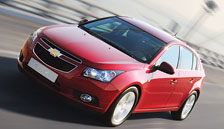What image is summoned up when the name Chevrolet is mentioned? American muscle cars? Cheap but cheerful city runarounds? Nothing at all?
The chances are that, unless you are a motoring aficionado, you have little knowledge of the brand – and, even if you are aware of the ‘golden bow-tie’, you are likely to greet its models with indifference.
That could be about to change. Chevrolet, under the global leadership of General Motors, is poised for a major sortie into the fleet market on the back of a comprehensive product offensive that will see it enter some of the biggest fleet car segments.
This year it is looking to double its corporate sales volumes to 9,000-plus for a 1% share of fleet.
Eventually, as its retail-to-fleet split migrates from 70:30 to 60:40 and new models are launched to fill gaps in the range, that share could rise as high as 3%, maybe even more.
Chevrolet is reluctant to speculate directly on its UK aspirations, although across Europe it is looking to raise market share from 3% to 5%, worth a million sales. The UK is its third biggest market (behind Germany
and Italy).
The catalyst for Chevrolet’s regeneration was ignited at the start of 2010 when the GMUK Fleet operation, which had four years earlier merged together the teams from Vauxhall, Chevrolet and Saab into a central hub, started to unravel.
Saab was sold to Spyker, while Vauxhall and Chevrolet finally concluded that they were drawing no value from presenting a dual-branded offering to fleets. As both companies now readily concede, the advantages of operating as separate organisations – not least the simplicity – far outweigh any notional benefit of the joint approach.
Chevrolet UK managing director Mark Terry, appointed in December 2008, began rebuilding the fleet operation. Keith Jones was duly appointed as national fleet sales manager and he began assembling his team.
Terry’s next move was to get Chevrolet’s own house in order and that meant withdrawing from the low profit, residuals-damaging short-cycle business that had become commonplace under GMUK Fleet.
He calls it a “brand building exercise”, although it resulted in Chevrolet’s total fleet volume dropping by 46% last year to 4,357 – a 0.45% share of the sector.
“We’ve now established a Chevrolet fleet team of our own and we are ready to serve the fleet market in the right way,” Terry tells Fleet News at the media launch of the revised Captiva sports utility vehicle.
“Our real fleet strategy is starting to take off.”
His confidence stems partly from Chevrolet’s strong relationship with Motability where demand for models like the Spark city car and new Orlando people carrier are helping to reinvigorate sales.
Terry describes it as “unprecedented”, and with justification – Motability sales in January were up year-on-year by 200%. He anticipates selling 2,500 this year.
New models like the Captiva and the Cruze five-door hatchback, due in time for the September plate-change, will further underpin Chevrolet’s fleet sales growth, in particular leasing via its own contract hire operation.
“We need the five-door Cruze to really offer fleets a credible vehicle,” says Terry. “It will see us into the core corporate and leasing sector. The Captiva will also be good in contract hire, but the Cruze is key.”
Each new vehicle launch takes Chevrolet into a new segment, offering the opportunity for organic growth. By the end of this year its model line up with serve two-thirds of the market, according to Terry.
Maximising the opportunity these new models provide requires enthusiasm and dedication, he adds.
“Our fleet team is engaging customers and understanding their needs. We are enthusiastic about what we do and that rubs off.
“We are also able to adapt to fleets’ needs because we are a small and flexible company. We are not encumbered with systems and history so we can adapt. The message to fleets is ‘come and talk to us’.”
This approach has seen measures implemented to tackle service, maintenance and repair bills via a new service plan and maintenance schedule.
Both are being introduced alongside new models, with the heightened self-confidence offered by their more reliable Euro 5-compliant engines.
“For fleets, SMR is an irritant which takes their vehicles off the road. This initiative says we are looking to reduce those intervals by which vehicles have to come to us for things like oil changes,” says Terry.

















Login to comment
Comments
No comments have been made yet.